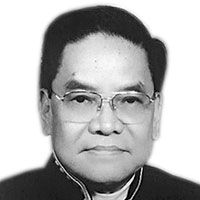Photodynamic therapy in biliary cancer

May 8, 2005 | 12:00am
Primary cancer of the bile ducts (cholangiocarcinoma) is an uncommon malignant tumor that may arise anywhere within the bile duct epithelium. Cholangiocar-cinomas are typically associated with an extremely poor prognosis, and curative surgical resection is possible for few patients. Thus, palliation of jaundice is the main goal. Endoscopic therapy is the primary modality for achieving nonoperative palliation. The addition of photodynamic therapy to endoscopic stent placement may improve palliation and prolong survival.
Successful palliation of obstructive jaundice can be achieved operatively, through percutaneous transhepatic cholangiography or stent placement, and endscopically, through endoscopic retrograde cholangiopancrea-tography (ERCP) or stent placement. The primary role of ERCP in the management of cholangiocarcinoma is to provide palliation of obstructive jaundice in order to relieve jaundice and pruritus, prevent recurrent cholangitis, and avoid hepatic failure due to progressive biliary obstruction by insertion of biliary stents.
Photodynamic therapy is performed by administering a photosensitizing agent that accumulates in tissue. Activation of the photosensitizer is achieved by directing laser light at the malignant biliary structure. This results in the formation of oxygen free radicals in the tumor issue, leading to ischemic necrosis of tumor cells. Several small studies show favorable results with the application of photodynamic therapy to patients with unresectable cholangiocarcinoma, particularly for patients with hilar tumors in whom the level of serum bilirubin is not reduced by at least 50 percent after appropriate stent placement. A prospective, randomized study evaluating the efficacy of photodynamic therapy was recently published. The median survival was significantly longer for patients receiving photodynamic therapy than for those receiving stents (493 days compared with 98 days; p<0.0001). Improvement in cholestasis, physical functioning, and quality of life were also significantly better in the photodynamic therapy group. The median survival was 426 days for patients who received open-label photodynamic therapy; this duration was significantly longer than that for the stent group. An important finding of this study was the improvement in jaundice for patients with failed biliary stenting, a group for whom there is little else to offer.
Endoscopic stenting has now become accepted as the primary palliative treatment for patients with unresectable cholangiocarcinoma. With encouraging data from a recent prospective, controlled trial using photodynamic therapy in addition to stenting, the option to use photodynamic therapy should be presented to patients until more studies (preferably prospective, randomized, and controlled) define the exact role of this treatment in the palliation algorithm.
Successful palliation of obstructive jaundice can be achieved operatively, through percutaneous transhepatic cholangiography or stent placement, and endscopically, through endoscopic retrograde cholangiopancrea-tography (ERCP) or stent placement. The primary role of ERCP in the management of cholangiocarcinoma is to provide palliation of obstructive jaundice in order to relieve jaundice and pruritus, prevent recurrent cholangitis, and avoid hepatic failure due to progressive biliary obstruction by insertion of biliary stents.
Photodynamic therapy is performed by administering a photosensitizing agent that accumulates in tissue. Activation of the photosensitizer is achieved by directing laser light at the malignant biliary structure. This results in the formation of oxygen free radicals in the tumor issue, leading to ischemic necrosis of tumor cells. Several small studies show favorable results with the application of photodynamic therapy to patients with unresectable cholangiocarcinoma, particularly for patients with hilar tumors in whom the level of serum bilirubin is not reduced by at least 50 percent after appropriate stent placement. A prospective, randomized study evaluating the efficacy of photodynamic therapy was recently published. The median survival was significantly longer for patients receiving photodynamic therapy than for those receiving stents (493 days compared with 98 days; p<0.0001). Improvement in cholestasis, physical functioning, and quality of life were also significantly better in the photodynamic therapy group. The median survival was 426 days for patients who received open-label photodynamic therapy; this duration was significantly longer than that for the stent group. An important finding of this study was the improvement in jaundice for patients with failed biliary stenting, a group for whom there is little else to offer.
Endoscopic stenting has now become accepted as the primary palliative treatment for patients with unresectable cholangiocarcinoma. With encouraging data from a recent prospective, controlled trial using photodynamic therapy in addition to stenting, the option to use photodynamic therapy should be presented to patients until more studies (preferably prospective, randomized, and controlled) define the exact role of this treatment in the palliation algorithm.
BrandSpace Articles
<
>
- Latest
- Trending
Trending
Latest
Trending
Latest
Recommended




























